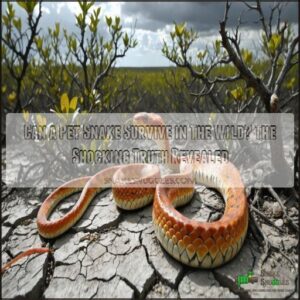This site is supported by our readers. We may earn a commission, at no cost to you, if you purchase through links.

Captive snakes often lack the instincts to hunt, avoid predators, or adapt to sudden climate changes.
They’re used to controlled environments where food, warmth, and safety are guaranteed.
Releasing one can harm local ecosystems by introducing diseases or competing with native wildlife.
Plus, non-native species can wreak havoc on biodiversity.
It’s not just risky for the snake—it’s a lose-lose for the environment too.
If you’re considering this, think twice.
There are better, responsible options for rehoming unwanted pet snakes that guarantee their safety and protect the wild.
Table Of Contents
- Releasing Pet Snakes Into The Wild
- Captive-Bred Vs Wild-Caught Snakes
- Can Pet Snakes Survive in The Wild?
- Snakes’ Needs in The Wild Vs Captivity
- Dangers of Releasing Pet Snakes Into The Wild
- What to Do With Unwanted Pet Snakes
- Environmental Factors Affecting Snake Survival
- Health Risks for Snakes in The Wild
- Reintroducing Captive-Bred Snakes to The Wild
- Promoting Responsible Snake Ownership
- Frequently Asked Questions (FAQs)
- Can you let a pet snake go in the wild?
- Can I release my pet snake into the wild?
- What does a snake need to survive in the wild?
- Can I release my snake in the wild?
- Is it cruel to keep a snake as a pet?
- Can I let my pet snake outside?
- Can pet snakes be released into the wild?
- Can a domestic snake survive in the wild?
- Is it okay to keep a wild snake as a pet?
- Can I keep a snake I found outside?
- Conclusion
Releasing Pet Snakes Into The Wild
When you release your pet snake into the wild, you’re endangering both the snake and the native ecosystem due to the animal’s lack of survival skills and potential to become an invasive species.
Your captive-bred snake hasn’t developed the hunting abilities or predator awareness needed to survive, while simultaneously posing a threat to local wildlife through competition, predation, or disease transmission, which can lead to a significant impact on the ecosystem as an invasive species.
Risks of Releasing Non-Native Species
Releasing non-native snakes into the wild creates four devastating ecological consequences:
- Ecosystem disruption – Pet snakes become invasive species that upset the delicate balance of local habitats
- Biodiversity loss – These newcomers outcompete native species for limited resources
- Disease spread – Captive snakes introduce unfamiliar pathogens to vulnerable wildlife populations
- Legal repercussions – Most jurisdictions have strict laws against releasing non-native species
The Burmese python invasion in Florida’s Everglades demonstrates this danger perfectly.
These former pets have decimated small mammal populations by up to 99% in some areas, proving that one released snake can trigger catastrophic ecological consequences.
Impact on Local Ecosystems and Wildlife
When pet snakes enter the wild, they become unwelcome agents of ecological disruption. Your former pet can quickly transform into an invasive species, creating ripple effects throughout the entire ecosystem.
These non-native reptiles often outcompete native wildlife for limited resources like food, water, and shelter, leading to significant biodiversity loss. The food web suffers dramatic imbalances when introduced snakes prey on species that haven’t evolved defenses against them.
Look at Florida’s Everglades, where Burmese pythons have decimated mammal populations by over 90% in some areas. This is a stark example of the devastating impact of invasive species on native wildlife.
Disease spread presents another serious threat. Pet snakes can introduce parasites and pathogens that native species have no immunity against, causing population crashes.
Perhaps most concerning is the potential for interbreeding with native species, creating genetic pollution that permanently alters wild populations and disrupts carefully balanced ecological relationships that took millennia to develop.
Challenges of Surviving in The Wild
Despite years of comfort, pet snakes face overwhelming challenges when thrust into the wild.
Their survival chances diminish rapidly due to:
- Climate Extremes – Without temperature-controlled enclosures, snakes can’t regulate body heat, leading to metabolic failure
- Hunting Difficulties – Captive snakes fed pre-killed prey lack essential wild hunting skills
- Predator Avoidance – Without natural camouflage instincts, they’re easily spotted by hawks, foxes, and larger snakes
- Shelter Unavailability – Finding safe hiding spots proves nearly impossible for inexperienced captive-bred reptiles
Snake adaptation to wild environments requires instincts developed from birth.
Released snakes also pose a risk of disrupting local ecosystems.
Without these skills, most released pets face starvation, predation, or death from exposure within days or weeks.
Captive-Bred Vs Wild-Caught Snakes
You’ll notice significant differences between captive-bred snakes with their limited genetic diversity and basic hunting skills versus wild-caught snakes that possess strong survival instincts and natural resilience.
Your pet snake has adapted to controlled environments with steady temperatures and regular feeding, making it poorly equipped to face the harsh realities of life in natural habitats.
It is also worth considering that this adaptation affects their ability to survive, as they have limited genetic diversity.
Genetic Differences Between Wild and Captive Snakes
The genetic blueprint of wild snakes differs remarkably from their captive counterparts.
While we often focus on a snake’s appearance, the DNA tells a more complex story.
Wild snakes possess extensive genetic diversity from generations of natural selection.
Their genes contain survival instructions honed by countless generations adapting to harsh environments.
Captive-bred snakes, however, often come from limited breeding pools focused on appearance rather than survival traits.
This leads to a significant difference in their genetic makeup compared to their wild counterparts.
| Trait | Wild-Caught Snakes | Captive-Bred Snakes |
|---|---|---|
| Genetic diversity | High variety | Limited pool |
| Instinct strength | Sharp, refined | Dulled, basic |
| Hunting ability | Naturally skilled | Often inexperienced |
| Stress adaptation | Highly resilient | Easily overwhelmed |
| Health vulnerabilities | Few genetic defects | More common issues |
This genetic gap explains why your pet snake would struggle if released.
Without the proper genetic toolkit, captive snakes lack the adaptation mechanisms needed for wild survival.
You’ll notice captivity effects most clearly in their reduced fear responses and hunting abilities.
Adaptation to Captivity
While wild snakes retain natural instincts, life in captivity fundamentally alters how pet snakes behave.
The shift from natural selection to human care creates significant adaptive changes.
| Trait | Captive Adaptation | Wild Behavior |
|---|---|---|
| Feeding Response | Expects regular meals | Hunts opportunistically |
| Predator Response | Limited defensive behavior | Strong survival instincts |
| Environmental Sensitivity | Comfortable in stable settings | Adapts to changing conditions |
This domestication effect creates a genetic bottleneck, permanently altering captive snakes’ survival potential.
Ability to Survive in The Wild
A shocking reality awaits captive snakes released into wilderness—their survival chances are minimal compared to their wild counterparts.
Most pet reptiles lack fundamental skills necessary for independent existence.
| Survival Factor | Wild Snake | Pet Snake |
|---|---|---|
| Hunting Skills | Instinctive predators | Expects pre-killed prey |
| Predator Avoidance | Naturally cautious | Dangerously naive |
| Climate Adaptation | Temperature experts | Dependent on controlled environments |
Without hunting skills, a captive snake can’t capture prey. They’ve never learned the precise striking techniques wild snakes develop from birth.
Disease resistance is another critical factor—pet snakes haven’t built immunity to common wild pathogens.
Genetic fitness plays a major role too. Captive breeding often prioritizes appearance over survival traits, creating snakes with beautiful patterns but poor adaptation capabilities.
The snake release wild phenomenon rarely ends well—captive snake wild survival rates remain dismally low even under ideal conditions.
Releasing them can lead to disruption of ecosystems, which is a significant concern for ecosystem balance and wildlife preservation.
Can Pet Snakes Survive in The Wild?
You’ll find that pet snakes often lack the survival skills needed to thrive in the wild after living in captivity.
Your snake’s chances of survival decrease substantially due to its inability to hunt effectively, avoid predators, and adapt to unpredictable environmental conditions, which affects its overall ability to thrive.
Factors Affecting a Snake’s Ability to Survive
While wild snakes evolved specialized survival traits, pet snakes face significant challenges when released outdoors.
Their captive upbringing lacks the training needed for wilderness survival.
Four critical factors determine if your pet snake will survive:
- Hunting Skills: Most pet snakes only eat pre-killed prey and never learn to track or capture live animals.
- Predator Avoidance: Without experience, they don’t recognize threats from hawks, raccoons, or larger snakes.
- Climate Adaptation: Pet snakes can’t regulate body temperature effectively in unfamiliar environments.
- Disease Resistance: Captive snakes lack immunity to wild pathogens and parasites.
Genetic diversity also plays a vital role – most pet snakes have limited genetic variation, reducing their adaptive potential.
Environmental Adjustments
When pet snakes face the wild, their bodies simply aren’t programmed for environmental adjustments.
Temperature regulation becomes their first major hurdle, as most captive snakes have lived with consistent climate conditions for their entire lives.
Habitat acclimation proves challenging when pet snakes encounter unfamiliar terrain without proper disease resistance.
Their bodies struggle with seasonal changes that wild snakes naturally anticipate.
In a wild environment, pet snakes face:
- Temperature control challenges from climate incompatibility
- Inability to recognize natural shelters
- Stress from constant environmental stimuli
- Adaptation to captivity that hinders survival instincts
- Metabolic disruptions from inconsistent conditions
Unlike their wild counterparts, pet snakes lack the physiological mechanisms needed for successful environmental shifts, making survival unlikely.
Ability to Find Food and Shelter
Why do most pet snakes struggle in the wild? Their ability to find food and shelter presents nearly insurmountable challenges.
Unlike their wild counterparts, captive snakes lack essential hunting instincts and prey recognition skills needed for survival. When suddenly facing natural environments, pet snakes can’t effectively locate food sources or identify safe shelter locations.
Their foraging skills remain undeveloped after years of receiving pre-killed meals in captivity.
Challenge Wild Snakes Pet Snakes
Without proper camouflage skills, pet snakes become easy targets for predators. They also struggle to locate water sources, further compromising their survival chances in unfamiliar territories.
Snakes’ Needs in The Wild Vs Captivity
You’ll find stark differences between what your pet snake needs in captivity versus what wild snakes require for survival.
In captivity, snakes rely on controlled temperatures and regular feeding schedules, while wild snakes must constantly hunt for food and seek appropriate shelter to regulate their body temperature, which is crucial for their existence.
Space and Environmental Considerations
Between the glass walls of captivity and the boundless wild lies a stark contrast in what snakes need to survive.
Your pet snake’s enclosure provides controlled comfort, while wild habitats demand complex adaptation skills.
| Environmental Factor | Captivity | Wild | Survival Impact |
|---|---|---|---|
| Enclosure Size | Limited (4-6 ft) | Unlimited territory | Reduced hunting abilities |
| Temperature Gradient | Precisely maintained | Fluctuates seasonally | Affects metabolism |
| Humidity Control | Regulated | Variable by region | Impacts shedding/health |
| Lighting Needs | Artificial cycles | Natural photoperiods | Influences behavior |
In captivity, you maintain perfect habitat enrichment with heating pads and misting systems. The snake natural habitat requires adaptation to temperature gradients that shift hourly.
Without developed skills to navigate climate survival challenges, captive snakes struggle to find food and shelter when temperatures drop below their comfort range.
Dietary Differences and Requirements
Beyond spacious habitats, dietary habits create a stark divide between captivity and wilderness.
Your pet snake’s feeding routine differs dramatically from what nature demands. In captivity, snakes receive consistent meals without hunting effort, while wild survival requires instinctive hunting skills.
| Aspect | Pet Snake | Wild Snake |
|---|---|---|
| Food Sources | Pre-killed prey, consistent schedule | Live prey, unpredictable availability |
| Nutrient Needs | Controlled diet, supplements | Variable nutrition, seasonal changes |
| Hunting Skills | Undeveloped, feeding response only | Refined stalking, striking techniques |
| Parasite Risks | Minimal exposure | Regular exposure through prey |
In captivity, snakes have a controlled diet, which contrasts with the variable nutrition they would experience in the wild, where they are also exposed to regular parasite risks through their prey, highlighting the significant differences in their lifestyles and survival strategies.
Social and Behavioral Adaptations
While dietary needs differ between environments, snake behavior shows even greater contrast.
Pet snakes lack the social and behavioral adaptations wild snakes develop through environmental cues and interactions.
| Adaptation | Wild Snakes | Captive Snakes |
|---|---|---|
| Hunting | Active pursuit with refined skills | Fed pre-killed prey |
| Predator Avoidance | Quick responses to threats | Limited defensive behaviors |
| Territory | Establish and defend space | No territorial requirements |
Your pet snake relies on learned skills rather than instincts. Without proper wild instincts for hunting or predator avoidance, captive snakes face significant challenges adapting to natural environments.
Dangers of Releasing Pet Snakes Into The Wild
When you release a pet snake into the wild, you’re threatening local ecosystems with potential invasive species and disease transmission.
Your former pet will likely struggle to survive without hunting skills while simultaneously competing with native wildlife for limited resources.
Risk of Introducing Diseases and Pests
While comfortable enclosures meet captive snakes’ needs, releasing them introduces serious disease risks to wild ecosystems.
Releasing pet snakes into natural habitats creates a dangerous pathway for disease transmission. Studies show exotic pets like snakes contribute to 35% of zoonotic disease cases in humans. Your captive serpent may carry parasites, bacteria, or viruses that wild populations lack immunity against, potentially devastating native species.
Wild snake populations face multiple health threats when encountering released pets:
- Salmonella and botulism can spread to indigenous wildlife
- Captive parasite spread affects local populations with weakened immunity
- Environmental contamination occurs through shedding and waste
- Native species impact includes reduced reproduction and survival rates
- Zoonotic disease risk extends to humans who contact affected areas
The Burmese python invasion in Florida’s Everglades demonstrates how released pets can trigger ecological crises, highlighting the importance of responsible ownership.
Impact on Local Snake Populations
When pet snakes enter the wild, they can devastate local snake populations through multiple mechanisms.
| Impact Type | Effect on Native Snakes | Ecological Consequence |
|---|---|---|
| Resource competition | Reduced food availability | Population decline |
| Disease transmission | Spread of captive pathogens | Mass mortality events |
| Hybridization risks | Genetic pollution | Loss of unique adaptations |
Pet snakes, often bred for distinctive traits, can breed with wild snakes, causing genetic pollution that weakens survival traits evolved over thousands of years.
These invasive snake species create predation pressure on native wildlife, disturbing the ecological balance. In areas with limited resources, competition becomes fierce, pushing native species toward extinction. The spread of novel pathogens compounds these problems, introducing diseases that wild populations haven’t developed resistance against, leading to mass mortality events and population decline.
Potential for Harm to Humans and Other Animals
Three key dangers emerge when pet snakes enter the wild.
First, snake bites from larger species pose public safety risks, especially when unfamiliar snakes appear in residential areas.
Second, escaped pets can become invasive snake species, competing with native species for resources and disrupting local food chains.
Third, these released animals may carry diseases that transmit to wildlife, causing ecological impact beyond their immediate presence.
The venom toxicity of some species compounds these concerns, creating ecosystem disruption that affects both humans and animals alike.
What to Do With Unwanted Pet Snakes
You’ll want to explore rehoming options through reptile rescues or local herpetological societies rather than releasing your unwanted snake into the wild.
Contacting professional organizations guarantees your snake receives proper care while protecting native ecosystems from potential damage caused by non-native species.
Rehoming and Reptile Rescue Options
While releasing snakes into the wild poses serious ecological threats, there are humane alternatives for unwanted snake pets.
Numerous rescue resources exist specifically for reptiles, offering surrender options that keep both ecosystems and your snake safe.
When considering rehoming, you have several practical paths:
- Contact specialized reptile rescues that understand proper snake care and can match your pet with knowledgeable adopters.
- Explore sanctuary placement through established snake rescue organizations that provide permanent homes for surrendered reptiles.
- Consider temporary fostering programs where your snake receives care while awaiting permanent adoption.
The adoption process typically involves an application and sometimes a small donation. Many reptile shelters even offer products for reptile wellbeing. Many reptile shelters even offer support with transportation logistics.
Local Regulations and Regulations
When rehoming snakes, you must navigate local wildlife regulations first.
Most jurisdictions have strict snake release laws making it illegal to release non-native pets into the wild. Specific permit requirements apply to venomous, endangered, or native species.
Some regions enforce species restrictions and import regulations with significant penalties for violations. Check with your local wildlife department about reptile laws before making decisions.
Wildlife rules vary by location—California and Illinois have particularly stringent enforcement policies to protect native ecosystems from introduced species.
Responsible Snake Ownership
Moving beyond regulations, ethical snakekeeping forms the foundation of responsible snake ownership.
When you can’t keep your snake, responsible pet owners have several options instead of releasing it into the wild:
- Contact reputable reptile rescues that specialize in exotic animal rehoming
- Reach out to local herpetological societies for rehoming assistance
- Ask pet stores if they accept surrendered animals for adoption
- Join online reptile communities where experienced keepers may adopt
Making informed decisions about rehoming demonstrates your commitment to both your pet’s welfare and environmental protection. Secure enclosures and proper species research beforehand can prevent the need for rehoming altogether.
Environmental Factors Affecting Snake Survival
You’ll face numerous environmental challenges when releasing a pet snake into the wild, including temperature extremes, food scarcity, and predator threats that captive snakes aren’t equipped to handle.
Without the carefully controlled conditions of captivity, your pet snake will struggle to regulate its body temperature, find appropriate shelter, and hunt effectively, dramatically reducing its chances of survival.
Climate, Temperature, and Humidity
After rehoming options, let’s examine how climate factors determine a pet snake’s survival chances in the wild.
Temperature regulation poses the greatest challenge for released pet snakes. Unlike their carefully controlled terrariums, the wild offers unpredictable temperature swings that can quickly become lethal. Pet snakes lack climate adaptation skills developed by their wild counterparts.
Here’s a quick breakdown:
Factor Wild Captivity
Without proper humidity needs and microclimate understanding, pet snakes can’t process food, shed properly, or survive seasonal changes.
Availability of Food and Water
Food and water availability pose significant challenges for pet snakes released into the wild.
Without the consistent meals provided in captivity, these animals face prey scarcity and unfamiliar water sources.
- Food sources in natural environments differ drastically from pre-killed prey offered in tanks
- Water sources vary in quality and accessibility compared to clean bowls
- Hunting skills remain underdeveloped due to lack of practice in captivity
- Dietary needs may not match available wild prey options
- Seasonal changes affect food availability, creating periods of potential starvation
A snake’s survival rate plummets when faced with these obstacles.
Wild-born snakes develop hunting abilities through necessity, while captive snakes never learn to track, ambush, or subdue live prey efficiently.
This fundamental gap in skills often leads to malnutrition or starvation despite surrounding food sources.
Presence of Predators and Competitors
In the wild, pet snakes face predators from all angles without the defensive skills needed for survival.
Their bright captive-bred colors make them easy targets for native predators.
- Hawks and owls spot these colorful reptiles from above, quickly turning them into meals
- Mammals like foxes and badgers detect and hunt snakes with far more skill than your pet can evade
- Larger native snakes compete aggressively for limited food sources and territory
Resource scarcity forces constant competition, while your snake lacks the predator avoidance instincts wild snakes develop from birth.
Without these survival adaptations, pet snakes typically succumb to predation within days of release, highlighting the importance of understanding the native predators.
Health Risks for Snakes in The Wild
Your pet snake will face numerous health threats in the wild including bacterial infections, parasites, and injuries without access to veterinary care.
Wild environments expose captive snakes to unfamiliar pathogens and predators that can quickly overwhelm their limited natural defenses.
Disease Transmission and Prevention
When released into the wild, pet snakes face severe disease risks while simultaneously threatening native ecosystems through bidirectional pathogen transmission.
Captive pathogens like bacterial infections, scale rot, and mouth rot can quickly overwhelm snakes with compromised wild immunity. Without veterinary intervention, these conditions often prove fatal.
Simultaneously, zoonotic risks increase as released snakes encounter unfamiliar parasites they lack resistance to, including intestinal worms, mites, and ticks that can cause anemia and systemic illness.
Preventative measures in captivity include regular health screenings and quarantine protocols, but these biosecurity protocols disappear upon release. The stark reality is that disease transmission works both ways—released snakes may introduce captive diseases to wild populations or acquire deadly wild pathogens they’ve never encountered, creating a dangerous health crisis for all involved.
Regular checkups can assist in recognizing disease symptoms, essential for early intervention.
Injuries and Trauma
Beyond disease concerns, physical trauma poses significant health risks for pet snakes released into unfamiliar territory.
Without proper instincts or experience, your previously sheltered pet faces numerous injury sources that wild-born snakes naturally avoid.
- Predator attacks often result in deep wounds that quickly become infected, leading to rapid health decline
- Habitat hazards like sharp rocks, fallen branches, and hostile terrain cause lacerations that rarely heal properly
- Road trauma claims countless snake lives as they bask on warm asphalt without understanding the danger
- Handling injuries from defensive encounters with humans or other animals frequently prove fatal
Without veterinary care, even minor injuries typically progress to life-threatening conditions, making survival unlikely, and highlighting the importance of considering the health risks for pet snakes in unfamiliar environments.
Parasites and Pests
While injuries can heal with time, parasites present a different challenge for pet snakes released into the wild.
Wild environments expose snakes to numerous parasites they’ve never encountered in captivity. Mite infestations and tick exposure can quickly overwhelm a pet snake’s limited immune defenses.
Internal parasites silently drain nutrients while wild pathogens attack from within.
| Parasite Type | Effect on Snake | Treatment Options |
|---|---|---|
| Ectoparasites (mites/ticks) | Blood loss, irritation | None in wild |
| Intestinal worms | Malnutrition, weight loss | Unavailable |
| Wild pathogens | Severe illness, death | No veterinary care |
Reintroducing Captive-Bred Snakes to The Wild
You’ll find that reintroducing captive-bred snakes to the wild presents significant challenges due to their lack of hunting skills and inability to recognize natural predators.
Most released pet snakes can’t adapt to wild conditions and face high mortality rates from starvation, predation, and exposure to unfamiliar diseases.
Challenges of Reintroduction
Reintroducing captive-bred snakes brings tough rehabilitation hurdles.
They often lack survival instincts needed for the wild.
Snake adaptation challenges include:
- Foraging Skills: Years of hand-feeding weaken hunting abilities.
- Predator Avoidance: Naiveté makes them easy prey.
- Behavioral Adaptations: Captivity dulls natural responses.
- Climate Adaptation: Struggles with temperature swings.
- Genetic Bottlenecks: Limited diversity hinders resilience.
Monitoring success is tricky, and disease introduction risks harming native ecosystems.
Rehabilitation and Conditioning
Preparing a pet snake for the wild isn’t as simple as letting it go; it requires structured survival training.
Pre-release conditioning focuses on rebuilding survival instincts like hunting, escaping predators, and sheltering. Snakes raised in captivity often lack these skills, so rehabilitation is key.
Survival training combines skill reinforcement and habitat familiarization. For example, introducing live prey helps restore hunting instincts, while controlled habitats teach navigation and adaptability. Health restoration and behavioral adjustments are also vital, ensuring the snake is physically fit and mentally equipped for the wild.
Here’s a quick look at snake rehabilitation techniques:
| Focus Area | Objective | Method |
|---|---|---|
| Hunting Skills | Revive natural instincts | Live prey scenarios |
| Physical Fitness | Boost stamina | Daily movement exercises |
| Habitat Familiarization | Adjust to wild environments | Gradual exposure to terrains |
Wildlife rehabilitation builds a snake’s confidence, giving it a fighting chance in nature. Access to essential snake products can substantially improve rehabilitation outcomes.
Monitoring and Evaluation
Tracking released snakes is essential to measure success and guarantee ethical wildlife conservation.
Use tools like population surveys and data collection through GPS or implanted transmitters to monitor movements and survival instincts.
Behavioral checks reveal how well they adapt to the wild, including hunting and predator avoidance, and habitat inspections, such as artificial dens, can confirm environmental adaptation.
Genetic analysis from environmental DNA helps assess long-term impacts, and this adaptive management approach guarantees the wild release supports both snake survival and ecosystem balance.
This approach offers valuable insights for future reintroduction efforts while protecting biodiversity, and ensures that the conservation efforts are ethically sound and support the overall goal of wildlife conservation.
Promoting Responsible Snake Ownership
Taking care of a pet snake means understanding its needs and ensuring it thrives in a safe, controlled environment.
By promoting responsible ownership, you help protect both your snake and the ecosystems it might otherwise harm.
Educating The Public About Snake Care
Caring for a pet snake isn’t just about feeding it; it’s about ensuring its long-term welfare and avoiding snake release risks.
Responsible snake ownership starts with understanding their unique needs and behaviors.
- Proper Handling: Always handle your snake gently to reduce stress and prevent bites.
- Habitat Enrichment: Create a comfortable enclosure with heat zones, hiding spots, and UVB lighting.
- Safe Feeding: Research your snake’s species to provide a proper diet and feeding schedule.
- Recognizing Illness: Watch for signs like refusal to eat or unusual activity to address health issues early.
Good care builds trust and supports your snake’s survival skills.
Understanding proper snake nutrition is essential for their health.
Encouraging Sustainable and Humane Treatment
Ethical snakekeeping starts with responsible breeding and proper care.
Always source snakes from certified breeders to protect wild populations and guarantee healthy genetics.
Focus on humane handling—limit interactions to reduce stress and prioritize enrichment strategies like adding climbing branches or hides to their enclosure.
Maintain ideal temperatures, humidity, and space to support their well-being. Remember, snakes thrive in stable, predictable environments.
By committing to responsible snake ownership, you’re not just enhancing your pet’s life—you’re also supporting conservation efforts and preventing the need for unethical snake release. Treating your pet humanely guarantees their welfare, whether in captivity or the wild.
Supporting Conservation Efforts and Regulations
Supporting conservation isn’t rocket science—it’s about small actions that matter.
Here’s how you can help:
- Report illegal snake trade to safeguard wildlife and promote ecosystem protection.
- Donate to habitat restoration programs or groups focused on snake conservation and ecological balance.
- Advocate for humane treatment and regulation adherence to curb invasive species.
- Share public education resources to foster environmental stewardship and awareness.
Every effort strengthens wildlife conservation and protects nature’s delicate balance.
Potential owners should understand boa constrictor laws to avoid legal issues, and recognize the importance of humane treatment and ecosystem protection for environmental stewardship.
Frequently Asked Questions (FAQs)
Can you let a pet snake go in the wild?
Releasing a pet snake into the wild isn’t safe or ethical.
It disrupts ecosystems, risks native wildlife, and exposes the snake to predators, disease, and starvation.
Rehome it responsibly through rescues or shelters instead.
Can I release my pet snake into the wild?
Releasing your pet snake into the wild isn’t safe or legal.
Captive snakes lack survival skills, risk spreading disease, and harm ecosystems.
Instead, consider rehoming through rescues or shelters to guarantee its safety and well-being.
What does a snake need to survive in the wild?
Imagine a snake making its way through life like a tightrope walker—it needs shelter, steady temperatures, water, food, and predator defense.
Without these essentials, survival becomes a gamble, especially for captive-bred snakes lacking wild instincts.
Can I release my snake in the wild?
You shouldn’t release your snake into the wild.
It’s likely illegal and harmful to ecosystems.
Pet snakes lack survival skills, risk spreading diseases, and face predators.
Rehome it through rescues, shelters, or herpetological groups instead.
Is it cruel to keep a snake as a pet?
Keeping a snake as a pet isn’t inherently cruel if you meet its needs.
Provide proper space, heat, and diet, and avoid neglect.
They thrive in controlled environments when cared for responsibly and ethically.
Can I let my pet snake outside?
Letting your pet snake outside isn’t safe.
They’re vulnerable to predators, temperature changes, and starvation.
Captive snakes lack survival skills for the wild, and releasing them can harm ecosystems.
Consider secure outdoor enclosures instead.
Can pet snakes be released into the wild?
You shouldn’t release pet snakes into the wild.
They lack survival skills, disrupt ecosystems, and may carry harmful diseases.
Instead, contact reptile rescues or herpetological societies to guarantee a safe and responsible rehoming.
Can a domestic snake survive in the wild?
A domestic snake rarely survives in the wild.
It lacks hunting instincts, struggles with predators, and can’t handle extreme weather.
Bright colors and unfamiliarity with local prey make it an easy target and vulnerable to starvation. It is also vulnerable to predators due to its lack of experience.
Is it okay to keep a wild snake as a pet?
About 80% of wild-caught snakes struggle in captivity due to stress and specialized needs.
It’s better to admire them in nature.
Captive environments often lack what wild snakes need to thrive, risking their health.
Can I keep a snake I found outside?
You can keep a snake you found outside, but it’s tricky.
Wild snakes may carry diseases or parasites and need specific care.
Research its species, verify legal compliance, and consider contacting a wildlife expert first.
Conclusion
Releasing a pet snake into the wild poses problems for both the snake and the environment.
Captive snakes struggle to survive without the controlled care they’re used to, often failing to find food or avoid predators.
Non-native species can disrupt ecosystems, harming native wildlife and biodiversity.
If you’re wondering, "Can a pet snake survive in the wild?" the answer is clear—it’s unlikely.
Instead, explore rehoming or rescue options to guarantee a safe, responsible solution for your snake.




















